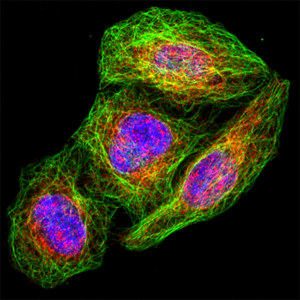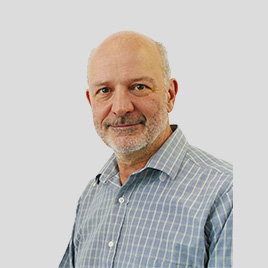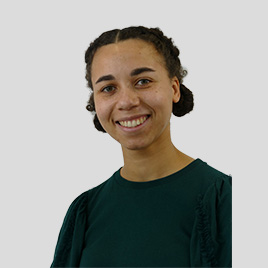Membrane Dynamics and Intracellular Trafficking
CATHY JACKSON & JEAN-MARC VERBAVATZ

Eukaryotic cells are characterized by their internal membrane compartments (organelles), which allow different cellular processes to take place in a well-adapted environment. However, in order for the cell to function as a whole, the various membrane-bound organelles, as well as the plasma membrane, must communicate through vesicular and non-vesicular trafficking. Our research focuses on intracellular lipid trafficking pathways. Their disruption leads to various human pathologies such as cancer, diabetes and neurodegenerative diseases, and these pathways are also subverted for the propagation of numerous viruses, including Hepatitis C and SARS-CoV-2.
Keywords : Organelle, membrane trafficking, membrane contact site, polarity, lipid, endoplasmic reticulum, Golgi, plasma membrane
+33 (0)1 57 27 80 04 Contact Cathy JACSKON / Jean-Marc VERBAVATZ
Eukaryotic cells are characterized by their internal membrane compartments (organelles), which allow different cellular processes to take place in a well-adapted environment. However, in order for the cell to function as a whole, the various membrane-bound organelles, including the endoplasmic reticulum (ER), Golgi apparatus, endosomes, lipid droplets, and mitochondria, as well as the plasma membrane, communicate through vesicular and non-vesicular trafficking (Jackson, Walch and Verbavatz, 2016; Kaczmarek, Verbavatz and Jackson, 2017; Jackson 2019). In vesicular trafficking, vesicles are transported from one compartment to their target, whereas non vesicular trafficking occurs at sites of close contact between organelles, named membrane contact sites (MCS), where the membranes of both organelles come together at a distance of 10-30 nm without fusing. Lipids can be transported by both vesicular and non-vesicular routes, but maintenance of the lipid composition of membranes requires lipid transfer at MCS (Jackson, Walch and Verbavatz, 2016). Disruption of lipid trafficking pathways leads to various human pathologies such as cancer, diabetes and neurodegenerative diseases, and these pathways are also subverted for the propagation of numerous viruses, including Hepatitis C and SARS-CoV-2.

Figure 1. Diagram illustrating the major organelles and membrane contact sites in a typical eukaryotic cell. ER, endoplasmic reticulum; PM, plasma membrane; LD, lipid droplet (Adapted from Jackson, Walch and Verbavatz, 2016).
We are using a multidisciplinary approach consisting of advanced imaging (light and electron microscopy, live cell imaging), biochemical approaches and proteomics analyses, to explore the following research questions:
1) Arf family GTPase regulation of organelle dynamics.
Arf family proteins are crucial regulators of membrane dynamics in all eukaryotic cells, having essential functions at multiple organelles, in vesicular trafficking and at MCS. For a number of years, our group has studied the small G protein (GTPase) ADP ribosylation factor 1 (Arf1) and its activators (Donaldson and Jackson 2011), uncovering new functions for these regulators.
Organelle dynamics in cells depends on microtubule motors that bind membrane compartments through adaptor proteins and pull them towards one or the other end of a microtubule. We discovered that the small G protein Arf1 and its activator GBF1 regulate the transport of mitochondria along microtubules and their spatial organization (Walch et al. 2018).
Lipid droplets (LDs) are the major energy storage depots of eukaryotic cells, which interface with membrane trafficking pathways. Our group uncovered a crucial role of Arf1 and its regulators in recruitment of LD-associated proteins to the LD surface (Donaldson and Jackson 2011, Bouvet et al. 2013, Jackson 2019). We have also described the mechanisms by which amphipathic helix-containing proteins such as perilipins are targeted to the LD surface (Donaldson and Jackson 2011, Copic et al. 2018).
In an exciting recent development, Arf-related proteins have been identified in newly discovered archaea lineages (the Asgard archaea), suggesting that these proteins were present in the common ancestor of archaea and eukaryotes. Thus Asgard archaea appear to be the long-sought lineage from which eukaryotes emerged, i.e. the host that entered into endosymbiosis with the mitochondrial progenitor. We are collaborating with experts in bioinformatics, biophysics and structural biology, to determine if these predicted Asgard Arf-related proteins possess the hallmark features of eukaryotic Arf family GTPases, and to explore their potential roles in eukaryogenesis.
2) Physiological functions of endoplasmic reticulum (ER) – organelle membrane contact sites (MCS)
Our studies have demonstrated functions of MCS in lipid transport from the ER to the plasma membrane, and their potential role in membrane growth (Moser von Filseck et al. 2015, Petkovic et al. 2014). The transport of lipids, including phosphoinositides at MCS, is an important determinant of the specific lipid composition of cell membranes (Jackson, Walch and Verbavatz, 2016), and it plays important roles in cellular rearrangements that occur during fundamental cell processes. Our group is currently studying the regulation and functions of MCS in processes such as cell division, cell migration, cell-cell contacts and apico-basal polarity and their implication in human disease.
2.1) MCS in cell division
Dramatic reorganizations of cellular organelles occur during cell division, essential for its successful completion. Improper cell division can result in numerous abnormalities, including aneuploidy and cancer. During division, membrane organelles undergo multiple steps of disassembly (nuclear membrane, Golgi apparatus…), fragmentation (mitochondria…) and spatial reorganization (mitochondria, ER…), followed by their reassembly at the end of mitosis. This is accompanied by coordinated changes in the distribution of phosphoinositides at the plasma membrane. We are studying the dynamic rearrangements of MCS in this process, the regulation of their function in lipid transport and their role in the choreography of membrane organelles during cell division.
2.2) MCS in epithelial cell polarity
The establishment and maintenance of cell polarity are crucial for the functions of epithelia, and are misregulated in human diseases such as cancer. In polarized epithelial cells, phosphoinositides are important determinants of the apical and basolateral plasma membrane identities. For example, the phosphoinositide PI(3,4,5)P3 is localized to the basolateral plasma membrane, but excluded from the apical membrane. Our goal is to decipher the role of MCS in determining the lipid composition of apical and basolateral membranes of epithelial cells and in the establishment and maintenance of cell polarity. Using cell biology approaches, we are investigating the membrane distribution of protein complexes at MCS, including lipid transfer proteins, and their function in the establishment of cell polarity.

Figure 2. Junction between two epithelial MDCK cells showing the presence of multiple ER-PM contact sites (MCS, yellow arrows in the inset, right panel). ER, endoplasmic reticulum; PM, plasma membrane. Photos, L. Daunas and V. Proux-Gillardeaux.
2.3) MCS in cell motility
Cell motility highly relies on the distribution of phosphoinositides that act as lipidic messengers mediating cytoskeleton reshaping and adhesion dynamics. We investigate the role of VAPA, an ER-resident MCS tether, during cancer cell motility processes including collective and single cell migration, cell adhesion and mecano-sensing. Using high-resolution microscopy, quantitative imaging and optogenetic tools, we intend to define in space and time how lipid exchange taking place at VAPA-mediated MCS controls cell motility.

Figure 3. A. Colon adenocarcinoma Caco-2 cells migrating during a wound healing experiment. Here, a leader cell has been tracked for several hours (blue line). B. ER-PM contact sites identified by electron microscopy at the leading edge of Caco-2 migrating cells (yellow boxes). C. We use fluorescent probes to study the dynamics of MCS during cell motility. The picture has been taken at the tip of the leading edge of a migrating cell (green : ER marker ; magenta : ER-PM contact sites). Photos, M. Heuzé and H. Siegfried
Team leaders
 Catherine JACKSON, Chercheur, JACKSON/VERBAVATZ LAB+33 (0)1 57 27 80 04, room 244B
Catherine JACKSON, Chercheur, JACKSON/VERBAVATZ LAB+33 (0)1 57 27 80 04, room 244B Jean-Marc VERBAVATZ, Enseignant-chercheur, JACKSON/VERBAVATZ LAB+33 (0)1 57 27 80 04, room 244B
Jean-Marc VERBAVATZ, Enseignant-chercheur, JACKSON/VERBAVATZ LAB+33 (0)1 57 27 80 04, room 244B
Members
 Marine ALVES, Ingénieur en biologie, JACKSON/VERBAVATZ LAB+33 (0)1 57 27 80 04, room 244B
Marine ALVES, Ingénieur en biologie, JACKSON/VERBAVATZ LAB+33 (0)1 57 27 80 04, room 244B Julie BEAUCOUSIN, Doctorante, JACKSON/VERBAVATZ LAB+33 (0)1 57 27 80 05, room 244B
Julie BEAUCOUSIN, Doctorante, JACKSON/VERBAVATZ LAB+33 (0)1 57 27 80 05, room 244B Mélina HEUZE, Enseignant-chercheur, JACKSON/VERBAVATZ LAB+33 (0)1 57 27 80 05, room 244B
Mélina HEUZE, Enseignant-chercheur, JACKSON/VERBAVATZ LAB+33 (0)1 57 27 80 05, room 244B Agathe VERRAES, Assistante-ingénieure en biologie, JACKSON/VERBAVATZ LAB+33 (0)1 57 27 80 05, room 244B
Agathe VERRAES, Assistante-ingénieure en biologie, JACKSON/VERBAVATZ LAB+33 (0)1 57 27 80 05, room 244B Anais VERTUEUX, Doctorante, JACKSON/VERBAVATZ LAB+33 (0)1 57 27 80 05, room 244B
Anais VERTUEUX, Doctorante, JACKSON/VERBAVATZ LAB+33 (0)1 57 27 80 05, room 244B
To contact a member of the team by e-mail: name.surname@ijm.fr
Jackson CL. Curr Opin Cell Biol. 2019 Aug;59:88-96. doi: 10.1016/j.ceb.2019.03.018. Epub 2019 May 7. PMID: 31075519 Review.
Franke C, Repnik U, Segeletz S, Brouilly N, Kalaidzidis Y, Verbavatz JM, Zerial M. Traffic. 2019 Aug;20(8):601-617. doi: 10.1111/tra.12671. PMID: 31206952
GBF1 and Arf1 interact with Miro and regulate mitochondrial positioning within cells.
Walch L, Pellier E, Leng W, Lakisic G, Gautreau A, Contremoulins V, Verbavatz JM#, Jackson CL#. Sci Rep. 2018 Nov 20;8(1):17121. doi: 10.1038/s41598-018-35190-0. PMID: 30459446 #co-corresponding authors
A giant amphipathic helix from a perilipin that is adapted for coating lipid droplets.
Čopič A, Antoine-Bally S, Giménez-Andrés M, La Torre Garay C, Antonny B, Manni MM, Pagnotta S, Guihot J, Jackson CL.Nat Commun. 2018 Apr 6;9(1):1332. doi: 10.1038/s41467-018-03717-8.PMID: 29626194
GBF1 and Arf1 function in vesicular trafficking, lipid homoeostasis and organelle dynamics.
Kaczmarek B, Verbavatz JM, Jackson CL. Biol Cell. 2017 Dec;109(12):391-399. doi: 10.1111/boc.201700042. Epub 2017 Nov 6. PMID: 28985001
Lipids and Their Trafficking: An Integral Part of Cellular Organization.
Jackson CL, Walch L, Verbavatz JM. Dev Cell. 2016 Oct 24;39(2):139-153. doi: 10.1016/j.devcel.2016.09.030. PMID: 27780039 Review.
The SNARE Sec22b has a non-fusogenic function in plasma membrane expansion.
Petkovic M, Jemaiel A, Daste F, Specht CG, Izeddin I, Vorkel D, Verbavatz JM, Darzacq X, Triller A, Pfenninger KH, Tareste D, Jackson CL#, Galli T#. Nat Cell Biol. 2014 May;16(5):434-44. doi: 10.1038/ncb2937. Epub 2014 Apr 6. PMID: 24705552 #co-corresponding authors
Targeting of the Arf-GEF GBF1 to lipid droplets and Golgi membranes.
Bouvet S, Golinelli-Cohen MP, Contremoulins V, Jackson CL.J Cell Sci. 2013 Oct 15;126(Pt 20):4794-805. doi: 10.1242/jcs.134254. Epub 2013 Aug 13.PMID: 23943872
Weber B, Greenan G, Prohaska S, Baum D, Hege HC, Müller-Reichert T, Hyman AA, Verbavatz JM.J Struct Biol. 2012 May;178(2):129-38. doi: 10.1016/j.jsb.2011.12.004. Epub 2011 Dec 13.PMID: 22182731
Pranke IM, Morello V, Bigay J, Gibson K, Verbavatz JM, Antonny B, Jackson CL. J Cell Biol. 2011 Jul 11;194(1):89-103. doi: 10.1083/jcb.201011118. PMID: 21746853
ARF family G proteins and their regulators: roles in membrane transport, development and disease.
Donaldson JG, Jackson CL.Nat Rev Mol Cell Biol. 2011 Jun;12(6):362-75. doi: 10.1038/nrm3117. Epub 2011 May 18.PMID: 21587297
Publications
- 2020, Manuel Giménez Andrés, “Interaction des hélices amphipathiques de la périlipine avec les gouttelettes lipidiques”, Université Paris-Saclay
- 2013, Samuel Bouvet, « Lipides et Trafic : Rôles de GBF1, facteur d’échange de la petite protéine G Arf1 », Université Paris Sud
- 2013, Aymen Jemaiel, « Etude du trafic membranaire vésiculaire et non-vésiculaire chez la levure », Université Paris Sud
- 2011, Iwona M. Pranke “Spécificité du ciblage membranaire par les motifs ALPS et l’α-synucléine”, Université Paris Sud

